
Psoriasis (also known as lichen scaling) is a non-infectious, chronic and often recurring skin condition.
Psoriasis, the symptoms of which determine its tendency to damage the periarticular tissue, manifests itself in the form of scaly papules. In addition, it should be noted that this disease is one of the most common skin lesions that appears at any age.
The etiology of this disease has not yet been fully studied and proven, but many dermatologists still agree that psoriasis is a disease that is directly related to hereditary genetic diseases.
No self-medication. See your doctor at the first sign of illness.
general description
Psoriasis is characterized by the duration and persistence of its own course. His remissions, which could last several months or several years, now point to his later return and lifelong duration. A spontaneous cure for this disease is extremely rare.
When trying to pinpoint a specific category of people who are predisposed to psoriasis, the solution is ambiguous. The fact is that psoriasis as a systemic process develops not only in people with actual immune disorders, but also in people who have certain functional or morphological disorders associated with the functions of various systems and organs.
Psoriasis belongs to the group of dermatoses and is one of the best-studied diseases. Meanwhile, none of the hypotheses that exist today can fully determine the nature of this disease. Against this background, the problems of its therapy and prevention are in the same uncertain and at the same time acute situation as before. Depending on the period, various ideas about the development of psoriasis have been suggested. This in turn led to the selection of a number of forms, each based on the results of certain laboratory studies and clinical observations.
- The hereditary nature of the disease. This implies the presence of psoriasis when considering several generations in which cases of this disease were accordingly identified. By the way, heredity is considered practically the most important and reliable cause of the development of psoriasis (in this case, psoriasis increases under the influence of various types of provoking factors).
- The metabolic nature of the disease. In this case, disorders of lipid metabolism (i. e. , cholesterol metabolism), decreased morbidity during periods of starvation, increased amount of phosphorus in psoriasis, etc. come into consideration.
- The viral nature of the disease. In this case, on the basis of numerous and long-term clinical observations, the concept of the direct involvement of a viral infection in the etiology of the disease under consideration was formed. For the same reason, infectious (and also viral) nature is the oldest as the theory of the development of psoriasis. So, the end of the 19th century was marked by cases of the formation of very extensive groups of formations of the psoriasis type, formed against the background of patients suffering from diseases such as scarlet fever and influenza. The systemic nature of the actual lesion, its recurrent and persistent course, the presence of an association with meteorological and heliophysical factors, as well as certain features inherent in the development of the rashes characteristic of psoriasis, also confirmed the infectious nature of the disease. The search for viral pathogens that could trigger the psoriasis process is currently underway.
- Endocrine nature of the disease. The theory of a direct relationship between the occurrence of psoriasis and its endocrine (as well as metabolic) nature in the recent past has been supported by many. When examining patients with psoriasis, certain disorders of the endocrine scale were not infrequently uncovered, which served as a justification for the relevance of such a relationship. In particular, they highlighted disorders related to the functional state of the sex glands, the influence of the menstrual cycle, pregnancy, childbirth and lactation, as well as the pronounced nature of the changes detected when examining the patients' pituitary-adrenal system.
- The neurogenic nature of the disease. It consists in the onset of the disease against the background of an actual nervous shock for the patient (more precisely, after the transmission). In about 30% of cases, the exacerbation of the disease is precisely due to stress. In this case, patients have a reduced ability to withstand the effects of stress and the subsequent transmission of its consequences. At the same time, their disorders (asthenic, vegetative-vascular-visceral, vegetative-vascular-dystonic and asthenodepressive) in combination with neurotic reactions provoke the formation or even intensify the characteristics of the prevailing vicious circle.
classification
As mentioned earlier, psoriasis is a chronic and recurring condition. Each of its existing forms can be assigned to one of the variants of the classification relevant for psoriasis, in which there is a distribution for pustular or non-pustular psoriasis. In general, the classification is as follows:
- Pustular psoriasis
- generalized psoriasis;
- annular psoriasis (annular pustulosis);
- palmoplantar psoriasis (psoriasis of the extremities, persistent palmoplantar pustulosis, barbera pustular psoriasis);
- chronic form of persistent akrodermatitis (psoriasis of the soles of the feet and palms, palmar-plantar psoriasis);
- herpetiform psoriatic impetigo.
- Non-pustular psoriasis
- Psoriasis vulgaris or psoriasis vulgaris, simple psoriasis (plaque, stable psoriasis in chronic form);
- Psoriatic erythroderma (erythrodermic psoriasis).
A number of authors maintain the need to supplement this classification, on the basis of which types or forms of psoriasis can be added in the following variants:
- seborrhea-like psoriasis (seborrhea psoriasis);
- Psoriasis of the napkin;
- drug-induced psoriasis;
- "Reversible psoriasis" (psoriasis of skin folds, flexor surfaces).
Psoriasis: symptoms
The first symptoms of psoriasis are the rash of miliary papules, which are characterized by a gradual increase along the periphery, while at the same time they are transformed into nummular and lenticular papules and merge with each other, as a result of which plaques of different sizes appear. The development of psoriasis in the skin defines three main stages for it.
First stage
This stage is called the progressive stage, it is caused by the formation of new formations on the skin (actually papules), as well as enlargement of the formations already on the skin. This is also accompanied by the formation of an erythematous border around the lesions (such a border is defined as a zone of peripheral growth). The plaque on the edges is not prone to peeling, while peeling, as the last stage of inflammation, does not keep pace with the growth process of psoriatic formations.
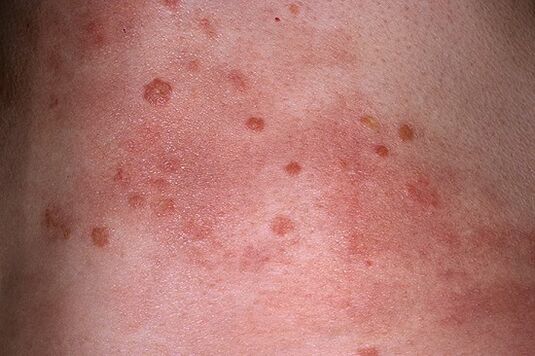
Second floor
The second stage defines a stationary period during which no new elements appear, but the existing elements in the form of plaques and papules do not change in size. In general, the appearance of papules can be completed at any stage, therefore the stationary phase can be accompanied by the simultaneous appearance of miliary papules, lenticular and nummular papules. Let's explain what the three types of papules listed are. So, numeral papules are elements of a rounded rash with a diameter of 15-20 mm (for this reason, these papules are also called coin-shaped). Lenticular papules, in turn, are elements of a rash, flat or convex, oval or round and lens-like. And finally, miliary papules, which have a conical shape of elements and are therefore similar to hemp seeds. Basically, these papules are small, with most of the area near the hair follicles.
Third section
This phase is reversed (or regressive). Its main characteristic is that the rashes gradually disappear, and a whitish border of the pseudosclerotic type is formed around the foci itself (it is defined as the Voronov border). During this time, some patients may experience mild itching. All subjective sensations are usually expressed insignificantly or even completely absent.
The appearance of rashes can be noted in all areas of the skin, but they are mainly localized in the area of the surface of the bends of the limbs, especially the elbow and knee joints, the region of the sacrum, the scalp (here, in particular, the area along the edge of the hair growth is distinguished, which is known as the "crown of psoriasis"). Psoriasis on the head, the symptoms of which, although determined by the severity of their own manifestations, do not lead to a change in the structure of the hair, as well as its loss.

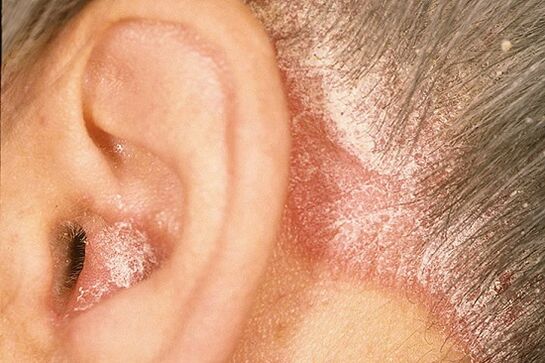
As for the concentration of plaques within the extensor surface of the knee and elbow joints, they often persist here for a long period from the moment the rash generally disappears (this characteristic defines them as "mandatory" plaques). Some patients are faced with the fact that folds of skin in the groin or mammary glands, as well as in the axillary glands, are affected, and often such a lesion can be isolated.
Irritated psoriasis
It develops against a background of active exposure of the skin to pre-existing progressive psoriasis of certain irritants, especially the sun's rays or certain ointments, as well as other types of irritants that affect plaques. These plaques in turn become more convex, the color changes to cherry-red, a hyperthermic belt forms in the area, as a result of which the sharp borders become somewhat blurred. This belt takes on a wrinkled appearance after the plaque dissolves.
Spotted psoriasis
This form of the disease is manifested in the form of a slight infiltration (in the general definition, infiltration is the impregnation of tissues with one or another substance) from the elements of the rash. They, in turn, look like spots (not papules). Patch psoriasis usually develops acutely and is also characterized by a resemblance to toxidemia. As the main method in differentiating the disease, the definition of the consistency of the course of the disease with its characteristic psoriatic triad is used.
Old psoriasis
This form of the disease can be considered symptomatic in the form of a strong infiltration from the side of plaques, their general cyanosis, with a hyperkeratotic or warty surface. This type of foci is especially difficult to cure, and their future transformation into a malignant tumor formation is not excluded (this rarely happens, but unfortunately it is not necessary to rule out this option).
Seborrheic psoriasis
This form of psoriasis, as the name suggests, develops in patients with seborrhea that is already relevant to them. The disease manifests itself on the scalp, in the area behind the auricles, on the chest, in the area of the nasolabial folds, within the subscapularis and shoulder blades of the back. The resulting psoriasis are subject to strong sebum saturation, as a result of which they stick together and remain within the plaque surfaces, which enables the disease to simulate a picture characteristic of seborrheic eczema.
Palmar-plantar psoriasis
The disease can manifest itself either in the form of ordinary psoriatic plaques and papules, or in the form of hyperkeratotic formations simulating calluses and calluses. In some cases, psoriasis on the hands, the symptoms of which in this case are noted on the palms of the hands (or on the legs - by definition, the soles of the feet), is continuous, which manifests itself in the form of increased thickening or cornification. The boundaries of this type of lesion are marked by clarity, in rarer cases this form of psoriasis is limited to the appearance of a large-ringed peeling.

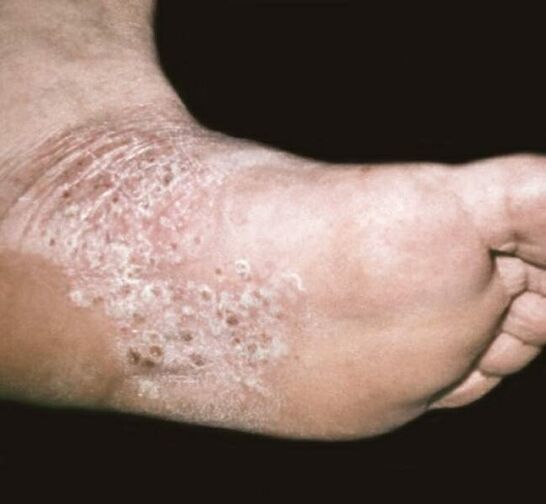
Exudative psoriasis
This form of psoriasis is characterized by excessive exudate formation during an inflammatory response that occurs as the psoriasis progresses. The exudate that gets to the surface of the papules saturates the accumulation of scales, thereby creating formations that look like crusts. These elements are secondary, define them as flake crusts, the color of these elements is yellowish. After their removal, a slightly bleeding and oozing surface is exposed. When dried and layered, scale crusts often form a massive type of conglomerate that resembles an oyster shell (this is already defined as rupioid psoriasis).
Guttate psoriasis
Guttate psoriasis, the symptoms of which appear suddenly, is characterized by the formation of multiple spots on the skin. Most often, the disease is diagnosed in patients between the ages of 8 and 16 years. Streptococcal infection is often a precursor to teardrop-shaped psoriasis.
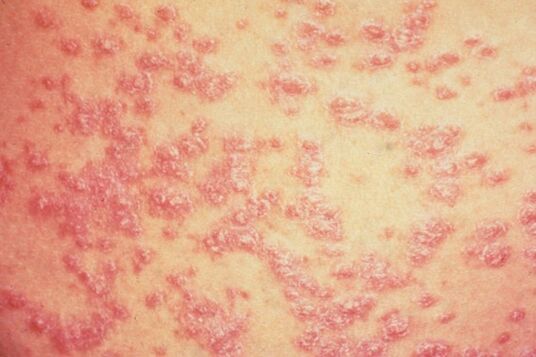
Psoriasis of the nails
Psoriasis of the nails, the symptoms of which allow the isolation of this type of psoriasis in three main forms, depending on the degree of damage to the nail, it can be atrophic, punctiform or hypertrophic.
A punctiform lesion is the formation of punctiform depressions on the nail plates, which can also be compared with the surface of a thimble. The manifestation of this form of psoriasis is possible in a slightly different version, which in its specificity is similar to onychomycosis. In this case, the nail plate changes color within the free edge, becomes dull and crumbles without much effort. An inflammatory border formed along the periphery of the affected nail plate area is noted as a sign that enables psoriasis to differentiate. It is represented as the edge of a papilla in the nail bed, visible through the nail plate.
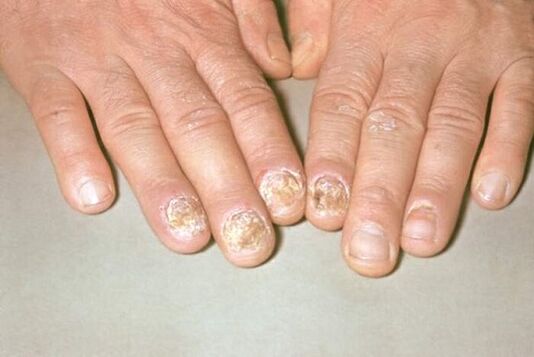

Psoriatic arthritis (psoriasis)
Psoriatic arthritis, the symptoms of which are manifested by an infiltration relevant to the periarticular tissue with simultaneous damage to the joints, mainly affects the interphalangeal joints. The possibility of large joints being involved in the pathological process has not been ruled out; the joints and joints of the sacroiliac spine are extremely rarely endangered in this regard.
It is important to take into account that, unlike other types of arthritis (which in the general definition means inflammation of the joints), psoriatic arthritis forms against a background of a preexisting psoriatic rash in the patient, often combined with nail damage. In addition, an important point can be distinguished that the onset of this type of arthritis is associated with an exacerbation of psoriasis in the skin, which in most cases acquires an exudative character.

Irrational treatment of the disease during its progression is often accompanied by the appearance of a nonspecific reaction of the body. It is naturally toxic-allergic and consists in the appearance of redness in the area not affected by psoriatic plaques. This redness affects the skin completely. This process is associated with an increased temperature (in the range no more than 39 degrees), as well as an increase in the lymph nodes, a feeling of tension in the skin, burning and itching. In common cases, there is also profuse peeling, thickening and peeling of the nail plates, hair loss. This picture already indicates the relevance of psoriatic erythroderma. Erythroderma ends with the restoration of the traditional version of the course of psoriasis.
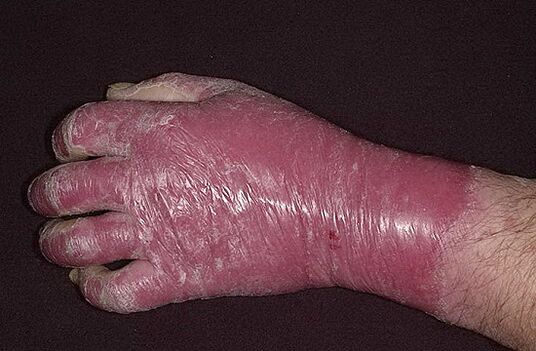
In general, the recurrence of the disease occurs in autumn-winter, as well as in spring-summer, which is an important factor that must be taken into account, including when prescribing the necessary treatment.
Psoriasis treatment
Before the appointment of treatment, a thorough examination of the patient is carried out, and already to determine specific measures in it, they are based on the stage of the course of the disease, its clinical diversity, the general condition of the patient, on the presence of concomitant diseases, the consistency of the symptoms of the disease with theSeasonality etc. is quickest and at the same time a favorable treatment result is achieved with uncomplicated forms of psoriasis with their short course, as well as with limited manifestations. In general, treating psoriasis is a rather laborious process, and in most cases a complete cure is impossible - the disease simply regresses (that is, it begins a period of its existence without symptoms), but this is also a positive outcome for it.
The main aim of treatment was to suppress symptoms as much as possible in combination with preventive measures.
First of all, with psoriasis, a diet is prescribed, in which those foods that provoke an exacerbation of the disease (spicy foods, chocolate, alcoholic beverages) are excluded from the diet. The restriction also applies to the consumption of smoked meat, honey, fried and fatty foods, etc. As the disease progresses, it is recommended to eat more fruits and vegetables (with the exception of red: apples, tomatoes, cherries, etc. ), fish and lean meat(cooked) to eat.
The course of psoriasis has a beneficial effect on its treatment in the conditions of the sanitary facilities. Taking into account the particular susceptibility of the skin in patients with psoriasis, it is recommended that exposure to the sun be avoided for 11 to 16 hours.
Drug treatment for psoriasis is based on the use of several methods. First of all, these are external means (creams, ointments, etc. ), systemic treatment drugs (injections, tablets, etc. ), and methods such as phytochemotherapy (phytotherapy), physiotherapy, etc. , methods of external treatment. In particular, among them, the following drugs were most commonly used:
- Salicylic ointment. With its help, the softening of the scales that have formed is ensured, which in turn offers the possibility of early elimination, along with a better absorption of another type of medicine. This ointment (0, 5% or 5%) is applied thinly to the affected areas of the skin 1-2 times a day. An important feature of the application is the use of a smaller amount of ointment with significant inflammation (that is, the stronger the inflammation in the nature of its manifestation, the less ointment is used for it). . Salicylic acid, which serves as the base of the drug, is also found in a number of other ointments used to treat psoriasis.
- Sulfur tar ointment (5 or 10%). The application of this ointment causes a reduction of inflammatory processes relevant to the skin. Contraindication to use is exudative psoriasis (i. e. psoriasis, accompanied by weeping crusts and scales). You can not apply this ointment on the skin of the face. Tar shampoos are used to treat scalp psoriasis.
- Naphthalene ointment. It is used to treat the regressive and stationary stages of the disease. The exacerbation or progression of psoriasis determines the inadmissibility of the use of this remedy. With the help of this ointment, severe itching and inflammation are relieved. A 5% or 10% ointment is used.
- Glucocorticosteroid drugs. Their use ensures a reduction in the intensity of inflammation. They are used only in short courses under the mandatory supervision of a specialist.
- Ointments with vitamin D. Such ointments have an anti-inflammatory effect and at the same time improve the course of the disease.
Systemic treatment is selected strictly individually and only by the attending physician. As mentioned earlier, it means using different pills, injections, etc.
Phytochemotherapy as a method of treating psoriasis consists of UV exposure of the affected areas of the skin. To do this, a special type of installation is used, which irradiates such areas without affecting healthy skin.
In general, the treatment of psoriasis can involve many different schemes implemented in practice, but none of these schemes is generally accepted due to the different course and specificity, so that the effectiveness of one of the schemes cannot be determined equally for all patients. Let's repeat that the treatment of the disease is carried out strictly individually, under the constant supervision of the attending physician.
If symptoms suggestive of psoriasis appear, it is necessary to contact a dermatologist and an infectious disease specialist.

























